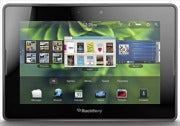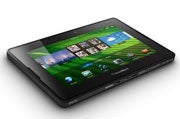Research In Motion’s (RIM) much-anticipated BlackBerry PlayBook tablet hit stores this week in the United States and Canada. RIM has reportedly shipped some 50,000 PlayBooks–a mere fraction of the hundreds of thousands of iPads Apple sold on its recent launch day, but a healthy chuck of gadgets nonetheless.
Whether you’re lucky enough to already have a BlackBerry PlayBook or are still considering the purchase, you’ll be happy to know that RIM packed a number of valuable security safeguards into its tablet to help ensure that your PlayBook experience is a safe, secure and private one.
The following BlackBerry PlayBook tablet security and privacy tips address how to browse the Web safely, how to deal with lost or stolen devices, and more.
BlackBerry PlayBook Password–On Tablet and “Bridged” Smartphone
One of the easiest, most effective ways to protect your BlackBerry PlayBook tablet and all the potentially-sensitive data on it is by assigning a security password to restrict unauthorized access.
To set a BlackBerry PlayBook password, simply click your PlayBook Settings icon in the top right corner of your tablet’s home screen–the icon looks like a gear of some sort. Next, click the Security option from the list on the left of your PlayBook screen, then tap Password from the options that appear in the center of your display.
Make sure the Enable Password option is set to On, and then enter in your new password twice to confirm it. Finally, I recommend setting your Password Lock After options to one of the lowest settings: either one or two minutes. Exit out of the Security/Password options and your PlayBook is now password protected.
Note: It’s also a good idea to protect your BlackBerry smartphone, if you employ one, with a handset password, but you should know that if you do use a BlackBerry smartphone password, you’ll need to enter it every time you want to access core BlackBerry apps via the PlayBook’s “BlackBerry Bridge” application. (For more on BlackBerry handheld security read, “BlackBerry Security Basics.” And check out this movies for a look at BlackBerry Bridge in action.)
BlackBerry PlayBook Wi-Fi and Bluetooth Security
Setting up Wi-Fi on the BlackBerry PlayBook is simple thanks to an intuitive setup tutorial, you can also boost your PlayBook wireless security in a few easy ways.
The best way to ensure your PlayBook is secure while browsing on a Wi-Fi network is to only employ networks secured with the latest Wi-Fi security standards, and by only surfing on networks you know and trust. Sometimes that means avoiding free, open networks in coffee shops, airports and hotels.
You’re always better off using your own, secure Wi-Fi hotspot or home network where available, or at least paying for secure access to a locked network, but sometimes you don’t have access to these wireless networks. If you do decide to employ an open or public network, beware that someone else could possibly access information stored on your tablet, and try to reduce the transfer of sensitive information, like passwords or financial details such as credit card numbers.
The BlackBerry PlayBook lets you employ Wi-Fi Protected Setup (WPS) so you can connect to compatible Wi-Fi networks via buttons or PIN numbers on a wireless router, therefore never having to send passwords or other potentially sensitive login information over the network. To employ the PlayBook’s WPS options, click the PlayBook Settings icon in the top right corner of your tablet’s home screen, but this time pick Wi-Fi from the list of options. Then tap the Use WPS option and follow the on-screen instructions.
Finally, you can reduce the risk of unauthorized access to your PlayBook via Bluetooth by ensuring that your tablet is not “discoverable” at all times. To modify your PlayBook Bluetooth settings, open the PlayBook Settings and pick Bluetooth. Next, make sure that the Discoverable option is set to either No or 2 Minutes.
You’ll need to go into your PlayBook’s Bluetooth settings and pick 2 Minutes every time you want to pair with another Bluetooth-enabled device, since this option will make your tablet detectable for only two minutes before making is “disappear.” But unknown Bluetooth devices won’t even be able to detect your tablet when it’s not discoverable, let alone connect without your knowledge.
BlackBerry PlayBook Tablet File Sharing Security
The BlackBerry PlayBook has a couple of options that let you manage and secure both wired and wireless tablet file-sharing via USB and Wi-Fi. If you don’t plan on sharing files between your PC and tablet, or between your tablet and other wirelessly-enable device, your best bet, from a security perspective is to simply leave both of these options turned off–both file sharing options are turned off by default until you enable them.
But you can still securely share files via PlayBook and other devices by assigning a file-sharing password that must be entered every time you want to share files. To enable wired- or wireless-file-sharing, or both, open up your PlayBook Settings and choose the Storage and Sharing option. On the next page, enable wired file sharing by clicking the box next to File Sharing to the On position. Do the same for the Wi-Fi Sharing listing if you wish to enable wireless file sharing.
Finally, to secure BlackBerry PlayBook file sharing, enable the Password Protect option on the Storage and Sharing screen, enter in your password twice to confirm it, and you’re good to go. With the file-sharing password enabled, you’ll need to enter in your access code before transferring files to and from your BlackBerry PlayBook.
 BlackBerry PlayBook Browser Security
BlackBerry PlayBook Browser Security
The BlackBerry PlayBook’s Webkit browser is one of the coolest, most valuable features packed into RIM’s tablet. However, there are secure–and private–ways to employ the PlayBook browser…and not so secure or private methods.
If you wish to surf the Web via PlayBook without storing any kind of information on your browsing, the best bet is to enable PlayBook Private Browsing. Private Browsing lets you surf the Web without leaving any easily-discoverable traces of your digital whereabouts, such as browsing history, cookies, etc. Turn on PlayBook Private Browsing by launching your PlayBook Browser and sliding your finger down from the top of your tablet’s display, to expose more browser options, including another gear-like icon labeled Options. Click the gear to open up your PlayBook browser options, then click to enable Private Browsing, which is turned off by default.
You can also change the duration for which your tablet stores browsing history, disable cookies, block pop-ups and more on this same browser options page.
In addition, you can block a Websites’ ability to identify your location at a given time, via PlayBook browser, by selecting the Permissions option in your browser settings menu and then flipping the Allow Websites to Access My Location option to “Off”.
Finally, if you value privacy and security above and beyond the advance browsing options, you can choose to disable the PlayBook browser’s Flash and/or Javascript, two Web technologies that are often targeted by miscreants–and sometimes compromised. In fact, one hacker already claims to have “rooted,” or gained system-level access, to the BlackBerry Tablet OS via a developer simulator, thanks to a Flash-related vulnerability.
BlackBerry PlayBook Tablet Full Security Wipe
All BlackBerry PlayBook users should know how to quickly “wipe” their tablets, or rapidly remove all personal data and applications, to return the device to a factory state, in case they ever need to return or exchange the device, or hand it over to another user.
Thankfully, RIM makes it very easy to perform a BlackBerry PlayBook security wipe. Just again open your PlayBook Settings options, and select the Security listing. On the next page, scroll down to and select the Security Wipe option, type the word “BlackBerry” into the provided space and click the on-screen Wipe Data button to initiate the security wipe.
Related posts:

If you could e-mail me with a few suggestions on just how you made your blog look this excellent, I would be grateful.
good write, good webpage design, maintain the great work